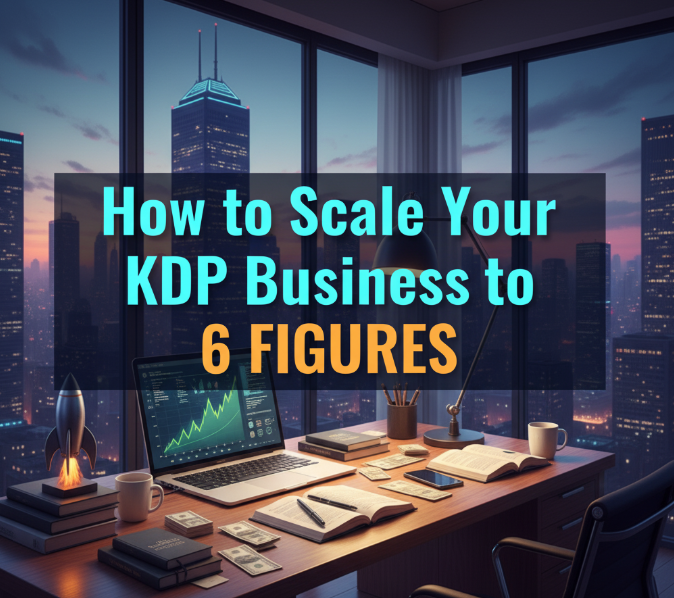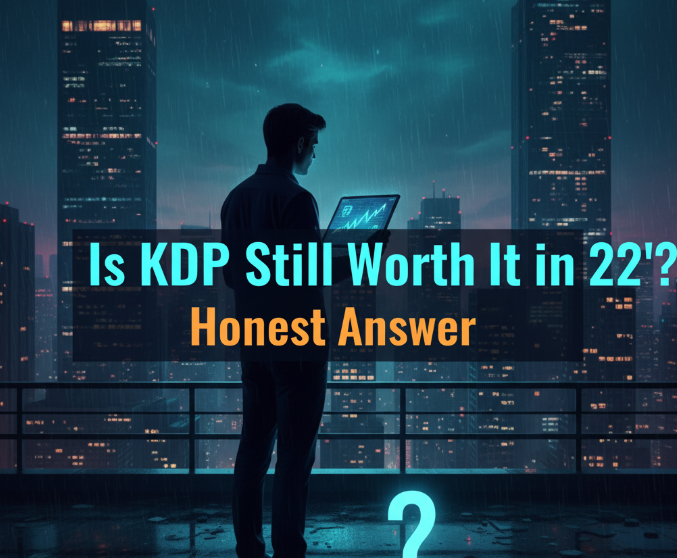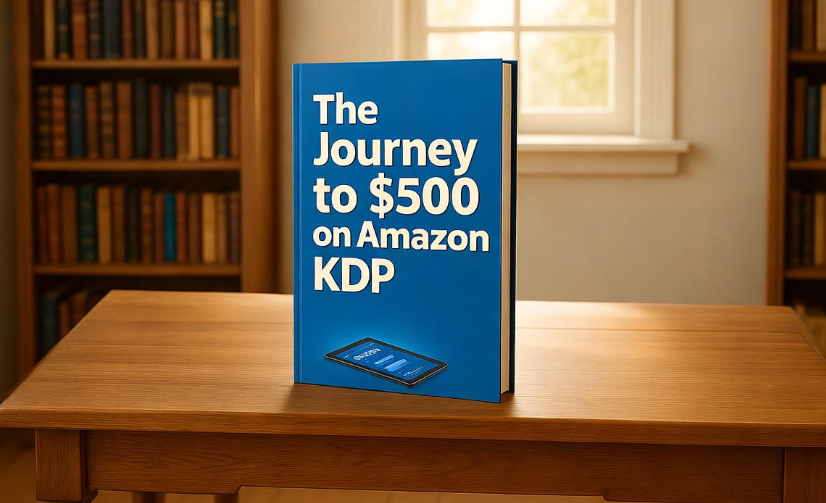Earning money from Amazon’s Kindle Direct Publishing (KDP) system sounds great, right? You write books, upload them and the money appears in your account while you sleep. But here’s a splash of cold water: the actual reality is that most KDP publishers make next to nothing — maybe $100 per month. The six-figure ones? They’re doing something completely different.
Build And Scale A KDP Business To $100,000+ Per Year
This isn’t some “luck” BS talk about writing the next Harry Potter. It’s simply running your publishing business as a proper business, implementing systems, tactics and wise decisions. So whether you are at the beginning stages or already earning a few hundred dollars a month, this blueprint lays it out for you on precisely how you can multiply your income and scale up your own publishing empire that pulls in huge amounts of money.
Why KDP Authors Can’t Seem to Break Through to Higher Income Levels
I’m going to get into specific strategies for growth in a moment, but first, let’s discuss why so many people are failing to scale. There are three mistakes most publishers make:
First, they post arbitrarily without any research. They write the stories they like, not the ones that sell. Second, they pause after writing one or two books and refuse to write more until the first couple of titles get on a best-seller list. Third, they ignore the business side entirely — no tracking, no testing, and no optimization.
The publishers making six figures? They do the opposite. They study obsessively, publish religiously and treat every decision as a business investment. That’s the mindset you need to adopt today.
Laying the Groundwork: The 1st Stages to Serious Success
Choose Hot Niches That Actually Sell
Your chosen niche is the thing that will make or break your potential income earner. There are some categories on Amazon that are gold mines, and then others that are just where books go to die. Here’s how to figure out who the winners are:
Begin by combing through Amazon’s lists of best sellers and recommendations, while paying close attention to the books that already sit between 5,000 and 50,000 in the overall store. These are far from inconsequential sales but not ones where the true blockbusters published by major firms with massive marketing budgets completely dominate.
Watch for books with plain covers and direct titles. If seemingly basic books are doing well, it’s because the content matters more to customers than fancy presentation. That’s your opportunity.
Check the review counts. Books in the sweet spot have 50-300 reviews. They’re proven items that sell, but the market is not overcrowded yet. Thousands of reviews and you’re already behind.
Profitable Niche Categories
| Niche Type | Examples | Average Monthly Income Potential |
|---|---|---|
| Low-Content Books | Planners, journals, notebooks, logbooks | $500-$3,000 per book series |
| Activity Books | Puzzle books, coloring books, word searches | $300-$2,500 per book |
| Educational Guides | How-to books, skill guides, test prep | $400-$4,000 per book |
| Special Interest | Hobby guides, niche cookbooks, pet care | $600-$5,000 per book |
The secret isn’t necessarily choosing one niche. Winning six-figure publishers diversify 3 to 5 hot niches. This safeguards you from market fluctuations and seasonal trends.
Create Quality Content
See, quality doesn’t mean that you have to be Shakespeare. For KDP, “quality” means that your book does what it says on the tin, seems professional and offers real value.
Quality, for low-content books such as journals and planners, means thoughtful page layouts, clear fonts and designs that are functional. It means credible information presented in a way that makes sense.
You cannot do everything yourself. Upwork and Fiverr, meanwhile, are two common sources that publishers will use to outsource content creation to freelancers. The trick is to identify good, dependable creators and build long-term relationships with them.
Plan to spend around $50-$200 per book for professional content creation (the more intricate, the more you can expect to pay). Yes, this does involve upfront investment, but one good book pays what you put into it back in the first month and then it becomes passive income for years.
The System That Drives Success
Publish Books in Strategic Batches
Here’s where just about everyone gets it wrong: they publish one book, wait a few months to see how it does (while doing little or no marketing beyond telling their core group of fans on social media), and then maybe, eventually publish another in three or six or 12 months. That’s not how you scale.
Successful publishers publish books in batches. Here’s a simple system:
Begin with 10 books in your initial niche in the first 60 days. Yes, 10 books in two months. It’s not as crazy as it sounds when you have templates, outsourcing and systems.
Every set should contain different topics within your main subject. If you’re putting out cookbooks, don’t simply create one vegetarian cookbook. Create the main cookbook and then spin off variations, such as “Quick Vegetarian Meals,” “Vegetarian Meal Prep” and “Budget Vegetarian Cooking.”
This approach works because you’re capturing a variety of search terms and customer requirements in the same niche. The books feed one another and your author name starts to be linked with authority on that subject.
Monthly Publishing Schedule for Scaling
| Month | Books Published | Total Catalog to Date | Projected Monthly Sales |
|---|---|---|---|
| Month 1-2 | 10 books | 10 books | $200-$800 |
| Month 3-4 | 15 books | 25 books | $800-$2,500 |
| Month 5-6 | 20 books | 45 books | $2,000-$5,000 |
| Month 7-9 | 15 books | 60 books | $3,500-$7,500 |
These figures are based on average book performance. Some of the books will flop, some of them will be your cash cows. The point is volume with smart selection.
Create Titles and Keywords That Convert to Sales
Keyword Research Has ALL the Money
The majority of KDP books do not succeed because no one can find them. Amazon is a search engine, and your book does not sell if it cannot be found in searches. Period.
Start with Amazon’s search bar. Just type in your topic and pay attention to the autocomplete suggestions. Those are real searches by real customers with ready credit cards.
Use what’s already free: Amazon search itself, Google Keyword Planner (yes, it also works for books) and leaf through competitor books’ keywords. See what the bestselling books in your category are ranking for.
Your aim: To find 7 keyword phrases per book that have a reasonably high number of searches but fairly low competition. Blend more general terms with targeted long-tail keywords.
Write Titles That Sell, Not Titles That Sound Cute
Your title is your biggest marketing tool. It has three things it needs to do: let people know what’s actually inside, get your main keyword in there and stand out from the competition.
Forget creative wordplay. On KDP, clarity crushes creativity. “The Keto Diet Cookbook: 500 Simple Low-Carb Recipes for Beginners” will sell more copies than “Keto Kitchen Magic” any day.
Your subtitle is equally important. This is where you fill in more keywords and benefits. Check out bestsellers in your niche and pay attention to how their subtitles enumerate the features or results.

How to Turn Your Pricing and Promotions Into Profit
Find Your Optimal Price Point
Pricing impacts not only your profit per sale, but also the number of sales you make in total. Set the price too high, and you scare off potential buyers. Price too low and you will be working harder for less money.
For most types of books, the sweet spot is between $2.99 and $9.99. This range affords you the 70% Amazon (for ebooks) royalty rate, which is essential to profitability.
Begin by looking up what other books in your subgenre are charging. If most successful books are selling at $6.99, start there. You can always tweak based on the data.
For paperbacks, your minimum price is based on printing cost. Amazon calculates this automatically. Add $2 to $5 to the base price for your profit margin. Take a 100-page paperback — it costs about $2.50 to manufacture that book, so when you sell it at $6.99, you’re making approximately a profit of about $4.49 with each sale.
Royalty Comparison by Price Point
| Ebook Price | Royalty Rate | Your Earnings Per Sale |
|---|---|---|
| $0.99-$2.98 | 35% | $0.35-$1.04 |
| $2.99-$9.99 | 70% | $2.09-$6.99 |
| $10+ | 35% | $3.50+ |
Most six-figure publishers keep their ebooks in the sweet spot between $2.99 and $7.99 to get the 70% royalty, yet still be competitive.
Marketing Tactics That Get Books In People’s Hands
Leverage Amazon’s Own Advertising Platform
Amazon Ads can seem overwhelming, but they are the quickest route to book sales. You do not really need a big budget to get decent results.
Start with automatic campaigns. Give each book a daily budget of $5–$10, and let Amazon determine which keywords convert. Review your data after a week’s time and manually create campaigns using high performing keywords.
The great thing about Amazon Ads is that you’re reaching people who are already shopping for books. These are not cold prospects—these are warm buyers who are actively seeking what you’re selling.
Monitor your ACoS (Advertising Cost of Sale). If you’re making $2.00 on a $0.50 spend, that’s a winning ad. If you are spending $2.00 to make $0.50, stop that campaign and test new keywords.
Create Email List for Long-Term Growth
Here’s a secret weapon: gathering email addresses of readers. Every six-figure KDP publisher has an email list.
Offer a free bonus with your book, such as a checklist, more recipes or a companion guide. Send them to a basic landing page where they put in their email to get the freebie.
Once you have emails, you’re then able to promote new book releases, run promotions and create a fan base who will buy everything that you publish. This effect is cumulative—each subsequent launch proves even more lucrative than the previous version.
Scaling Through Smart Outsourcing
What to Outsource and When
You can’t DIY your way to six figures. Successful publishers are business owners, not simply writers and designers.
Begin outsourcing the minute you’re doing consistent sales—even if it’s $500/month. Reinvest that money in help.
Common tasks to outsource:
- Content writing and book creation
- Cover design
- Formatting and uploading
- Keyword research
- Running ad campaigns
Keep these tasks in-house initially:
- Niche selection and strategic planning
- Quality control and final approval
- Financial tracking and business decisions
Building Your Publishing Team
| Role | When To Hire | Average Cost | Impact on Scaling |
|---|---|---|---|
| Content Writer | After 5-10 books | $50-$200 per book | High – Increases publishing speed |
| Cover Designer | After 3-5 books | $25-$100 per cover | High – Improves conversion rates |
| Formatter | After 10 books | $15-$50 per book | Medium – Saves time |
| Virtual Assistant | After 20 books | $5-$15/hour | High – Handles repetitive tasks |
| Ads Manager | After 30 books | $300-$1,000/month | Very High – Scales visibility |
Start with one freelancer and nail that relationship before adding more team members. Good outsourcing trumps cheap outsourcing every time.
Tracking Numbers That Actually Matter
The Key Six-Figure Success Metrics
You can’t manage what you don’t measure. The vast majority of publishers have never even glanced beyond a raw total royalty figure. That’s a mistake.
Track these metrics monthly:
- Sales per book
- Revenue per book
- Ad spend versus ad revenue
- Conversion rate (page views to purchase)
- Average royalty per sale
You can make a simple spreadsheet or use Publisher Rocket or KDP Analyzer to track this. Allocate an hour a week to go over your numbers and give yourself permission to make changes.
The books that are failing to perform at $20/month after three months? Stop promoting them and concentrate your energies on the winners. The books earning $200+/month? Learn from what’s working, and copy that formula.
Setting Realistic Revenue Goals
| Monthly Revenue | 6-Month Goal | 12-Month Goal | Action Steps |
|---|---|---|---|
| $0-$500 | $2,000-$3,000 | $5,000-$8,000 | Publish 30+ books, start ads strategically |
| $500-$2,000 | $4,000-$6,000 | $10,000-$15,000 | Scale publishing, improve ads, test new niches |
| $2,000-$5,000 | $7,000-$10,000 | $15,000-$25,000 | Build team, automate systems, expand formats |
What breaking six figures means is hitting around $8,500 a month average over time. You can do it with 80-150 books in moderate rotation.
Advanced Methods for Punching Through Revenue Ceilings
Write Series Instead of Standalone Books
Individual books don’t make a lot of money. Book series multiply your earnings because readers who come to the end of book one purchase book two right away, followed by three and four.
This is applicable for fiction (I’m sure you know that), but non-fiction as well. Write a set of cookbooks for different levels: easy, medium, hard. Or build seasonal planners: one for every season of the year.
Series also boost your Amazon ranking, since you are creating consistent sales velocity across multiple ASINs (Amazon product numbers).
Expand Into Multiple Formats
Don’t just sell ebooks. Publish paperbacks, hardcovers and even audiobooks of your successful titles.
Some customers just like a physical book and will not buy your ebook version.
For paperbacks — at higher prices, they will earn $3-$7 profit per book sold. Hardcovers can go even higher. Audiobooks, through an Amazon-owned platform called ACX, provide access to a whole new audience.
Here’s what one bestselling ebook at $4.99 can turn into:
- Ebook: $4.99 (earning you ~$3.50)
- Paperback: $12.99 (earning you ~$4.50)
- Hardcover: $24.99 (earning you ~$8.00)
- Audiobook: $14.95 (40% royalties)
Same content, four revenue streams.
Keeping Your Business Safe and Playing the Long Game
Follow Amazon’s Rules Religiously
If you break their terms, Amazon can close down your account with a snap. And with that goes your entire stream of income.
Don’t infringe upon copyrighted material. Don’t copy competitors’ books. Avoid misleading titles or descriptions. Avoid inappropriate content.
Review Amazon’s KDP terms of service at least annually. They update their policies, and ignorance is no excuse.
Diversify Beyond Amazon
Yes, Amazon is the largest game in town right now, but no smart publisher uses just one platform forever. After you’re consistently making money on Amazon, expand to:
- Barnes & Noble Press
- Apple Books
- Google Play Books
- Kobo
- Draft2Digital (distributes to several other platforms)
This shields your business from algorithm changes or policy tweaks that could make your Amazon income tank overnight.
A 12 Month Plan For Six Figures
Now, let’s assemble all this into a realistic timeline:
Months 1-3: Foundation Phase
- Research and find 3 profitable niches
- Publish your first 20 books (ebook/paperback)
- Set up basic tracking systems
- Begin learning Amazon Ads with low budget
Months 4-6: Scaling Phase
- Publish 30 more books
- Identify your 5 best performing books and make variations
- Expand into one new niche
- Increase ad spend on winning books
- Start building your email list
Months 7-9: Optimization Phase
- Publish 40 more books
- Launch your first book series (3 or more books)
- Hire a virtual assistant
- Publish books in multiple formats
- Test pricing and optimize for profit
Months 10-12: Expansion Phase
- Publish another 30 books in proven niches
- Fully automate content creation and formatting
- Ramp ad budgets on profitable campaigns
- Expand to platforms other than Amazon
- Plan for your next 6 months of growth
At 12 months in, you should have 120+ books with a few proven winners that sell every day.
Real Talk: The Investment Required
You won’t scale to six figures for free on KDP. You’ll have to spend time, money or both. Here is what smart investment looks like:
If you’re handling all of it yourself, plan to put in 20-30 hours per week. If you’re outsourcing a lot, you might work 5-10 hours a week on your business, but spend $2,000 to $5,000 in the first six months on content creation and ads.
The most successful publishers incorporate both approaches: doing some work themselves but outsourcing the bulk, spending between $1,000 and $2,500 in those first six months.
The good news? That investment pays off quickly when you find profitable books. A hit book will generate passive income of $500-$3,000 per month for years with relatively little ongoing work.

Frequently Asked Questions
How long does it actually take to make 6 figures on KDP?
The majority of publishers who hit six figures do so within 18-36 months of serious, consistent effort. The first year is about learning, building your catalog and finding what works. The second year is about scaling those things that worked. Not many people reach six figures in their first 12 months, however, it’s possible if you are willing to invest heavily in the business and if you have had previous business experience.
Must I write every single book myself?
No. The vast majority of six-figure KDP publishers outsource a good chunk of content writing. For low-content books like journals and planners, you’re laying out content rather than writing. For non-fiction how-to books, you can contract ghostwriters or legally aggregate free public domain material. You should focus your personal effort on the strategy, not production.
How many books would I need to make $100,000 a year?
This varies widely, but here’s a consistent average: if your average book makes $50/month, you’d need 167 books to hit $100k/year. If the average for each book is $100/month, you would require 84 books. A typical successful publisher has between 80 and 150 books, with a combination of low and high performing titles. Your top 20% of books will probably make you about 80% of your money.
What’s the best type of book for a beginner looking to scale fast?
Low-content books (journals, planners and notebooks) or activity books (puzzles, coloring) are the easiest to get started with because they involve less writing and content creation. You can release more books more quickly, which increases your learning rate and income generation. Once you know the platform better, start adding higher-priced educational/how-to books.
Should I use my real name or pen name?
Use different pen names for various niches. This gives you the opportunity to develop niche authority (customers see you as an expert in that one topic) while safeguarding your business if one of those niches isn’t successful. Create basic, professional-sounding pen names that tie in with your niche. For cookbooks, use something warm and friendly. Business books should use something that sounds professional and authoritative.
What is a good budget for Amazon Advertising?
Begin small and expand strategically. Start at $5-$10 per day total combined across your top books. As you find winning (profitable) campaigns, scale the budget up on those winners. Some six-figure publishers spend $500-$2,000 each month on ads but they are generating $5,000 to $15,000 in ad-attributed sales. Never spend more on ads than you are willing to lose while you experiment.
Can I do it with only a few hours each week?
Yes, but it will take longer. With 5 to 10 hours a week, focus on strategic actions and outsource everything else. You’ll grow more slowly (maybe 5-10 books per month instead of 15-20), but you can still grow your income into a substantial amount in two-three years. Consistency is the key, and you have to be smart about who you outsource to.
What’s the number one mistake new publishers make trying to scale?
Publishing random books without research. Close second: quitting after 10-20 books without getting results. It takes 80+ books with strategic focus to reach six figures. Very few people get that far because they give up long before they have enough catalog size. Third mistake: not tracking the numbers and making decisions based on emotions instead of data.
Your Next Steps Start Today
Getting your KDP business to six figures is 100% possible. It has nothing to do with luck or talent – it’s all about running your publishing business like an actual business, complete with systems, consistency and smart strategies.
Stop sitting and waiting for the right book idea to appear. Stop overthinking your first steps. Begin with research, publish your first batch of books and iterate as you learn. Every six-figure publisher began right where you are today: no books published and plenty of doubts.
The gap between publishers who make it and those who don’t isn’t talent or connections. It is persistence with smart strategy. You now have the roadmap. The question is: Are you going to follow it?
Your first step is due today. Pick your first niche, research your first book idea and commit to publishing at least 10 books within the next 60 days. You don’t build to six figures overnight, you do it one book at a time.
The publishing empire you’re seeking is on the other side of taking massive action. Start building it today.




